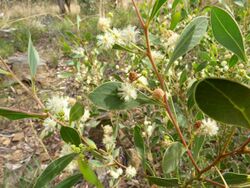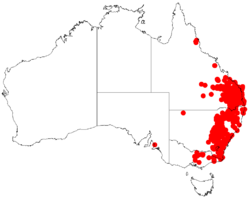Biology:Acacia penninervis
| Hickory wattle | |
|---|---|

| |
| Scientific classification | |
| Kingdom: | Plantae |
| Clade: | Tracheophytes |
| Clade: | Angiosperms |
| Clade: | Eudicots |
| Clade: | Rosids |
| Order: | Fabales |
| Family: | Fabaceae |
| Subfamily: | Caesalpinioideae |
| Clade: | Mimosoid clade |
| Genus: | Acacia |
| Species: | A. penninervis
|
| Binomial name | |
| Acacia penninervis DC.
| |

| |
| Occurrence data from AVH | |
| Synonyms | |
Acacia penninervis, commonly known as mountain hickory wattle, or blackwood,[3] is a perennial shrub or tree is an Acacia belonging to subgenus Phyllodineae,[4] that is native to eastern Australia .
Description
The shrub or tree typically grows to a height of 2 to 8 m (6 ft 7 in to 26 ft 3 in) and has an erect to spreading habit. It has finely or deeply fissured bark that is usually a dark grey colour. The glabrous branchlets are more or less terete and occasionally covered in a fine white powdery coating. Like most species of Acacia it has phyllodes rather than true leaves. The glabrous and evergreen phyllodes have a narrowly oblanceolate or narrowly elliptic shape and are straight to slightly curved with a length of 5 to 15 cm (2.0 to 5.9 in) and a width of 7 to 40 mm (0.28 to 1.57 in) with a prominent midvein and marginal veins and are finely penniveined. The plant blooms throughout the year producing pale yellow flowers.[4]
Taxonomy
The species was first formally described by the botanist Augustin Pyramus de Candolle in 1825 as part of the work Leguminosae. Prodromus Systematis Naturalis Regni Vegetabilis. It was reclassified as Racosperma penninerve by Leslie Pedley in 1986 then transferred back to genus Acacia in 2006. Other synonyms include; Acacia impressa, Acacia penninervis var. impressa and Acacia impressa var. impressa.[5]
Varieties
- Acacia penninervis var. longiracemosa
- Acacia penninervis var. penninervis
Distribution
It occurs in the Australian states of the Australian Capital Territory, New South Wales, Queensland and Victoria, and as an introduced species on New Zealand's North Island and South Island.[6][1] The variety A. p. var. penninervis occurs in the same Australian states of the Australian Capital Territory, New South Wales, Queensland, and Victoria.[7] The variety A. p. var. longiracemosa occurs in coastal districts of southern Queensland, and northern New South Wales.[8]
Uses
The 1889 book 'The Useful Native Plants of Australia’ records that common names included "Hickory" and "Blackwood" and that "The bark (and, according to some, the leaves) of this tree was formerly used by the aboriginals [sic.] of southern New South Wales for catching fish. They would throw them into a waterhole when the fish would rise to the top and be easily caught. Neither the leaves nor bark contain strictly poisonous substances, but, like the other species of Acacia, they would be deleterious, owing to their astringency."[9]
Its uses include environmental management.[1] The tannin content of the bark is approximately 18%.[10]
See also
References
- ↑ 1.0 1.1 1.2 ILDIS LegumeWeb
- ↑ "Synonyms of mountain-hickory (Acacia penninervis)". Encyclopedia of Life. http://eol.org/pages/646755/names/synonyms. Retrieved 2014-04-05.
- ↑ "Common names for mountain-hickory (Acacia penninervis)". Encyclopedia of Life. http://eol.org/pages/646755/names/common_names. Retrieved 2014-04-05.
- ↑ 4.0 4.1 PlantNet
- ↑ "Acacia penninervis Sieber ex DC.". Atlas of Living Australia. Global Biodiversity Information Facility. https://bie.ala.org.au/species/https://id.biodiversity.org.au/node/apni/2918297#names. Retrieved 19 July 2020.
- ↑ "ABRS Flora of Australia Online Search Results: Acacia penninervis Sieber ex DC.". Flora of Australia Online. Australian National Botanic Gardens. http://www.anbg.gov.au/abrs/online-resources/flora/stddisplay.xsql?pnid=40904. Retrieved 2014-03-29.
- ↑ "ABRS Flora of Australia Online Search Results: Acacia penninervis Sieber ex DC. var. penninervis". Flora of Australia Online. Australian National Botanic Gardens. http://www.anbg.gov.au/abrs/online-resources/flora/stddisplay.xsql?sn_infspnm=penninervis&sn_infsprnk=var.&sn_fam=mimosaceae&sn_gen=acacia&sn_sp=penninervis. Retrieved 2014-03-29.
- ↑ "ABRS Flora of Australia Online Search Results: Acacia penninervis var. longiracemosa Domin". Flora of Australia Online. Australian National Botanic Gardens. http://www.anbg.gov.au/abrs/online-resources/flora/stddisplay.xsql?sn_infspnm=longiracemosa&sn_infsprnk=var.&sn_fam=mimosaceae&sn_gen=acacia&sn_sp=penninervis. Retrieved 2014-03-29.
- ↑ J. H. Maiden (1889). The useful native plants of Australia : Including Tasmania. Turner and Henderson, Sydney. https://primo-slnsw.hosted.exlibrisgroup.com/primo-explore/fulldisplay?docid=SLNSW_ALMA21105097830002626&context=L&vid=SLNSW&search_scope=EEA&tab=default_tab&lang=en_US.
- ↑ von Mueller, Ferdinand (1884). Select extra-tropical plants readily eligible for industrial culture or naturalization. Detroit, Michigan: George S. Davis. p. 7. https://archive.org/details/bub_gb_CfDcl2m-6BMC.
Wikidata ☰ Q2710338 entry
 |

